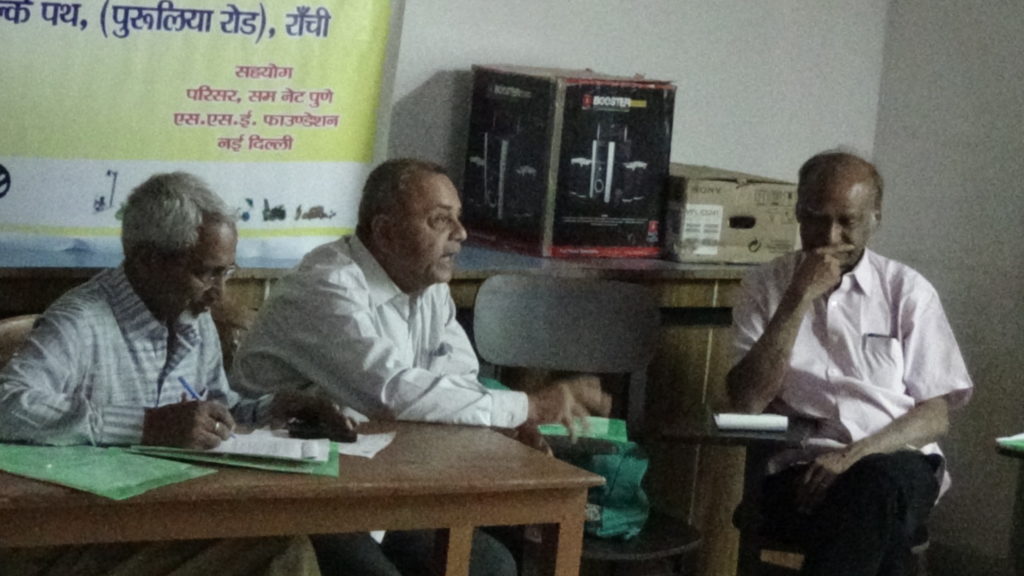“Before bringing culture on road, let’s understand the culture that road itself is”
These were the words of Adv. Rashmi Vatsyayan, one of the participants in the SUM Net Multi-stakeholders meeting in Ranchi. Capital of Jharkhand, the city of Ranchi is urbanizing rapidly and with it facing massive transport challenges. While in its policy language the city is trying to ensure equitable, affordable and safe transport, one can easily recognize the unabashed primacy enjoyed by private vehicles over public transport, in reality.
In this policy environment, a meeting was conducted to deliberate upon designing walkable streets in Ranchi and beginning a people’s movement to enforce the safety of pedestrians. The meeting started with Dr. Vishwanath Azad talking about the origins of “Pedestrian Forum for Equal Road Rights” 4 years back, and the interventions sought for provision of public toilets and amenities on streets. The forum was also involved in ensuring that streets are accessible and safe for women. This was followed by delineating the activities carried out this year which focused on mapping three different streets in Ranchi. Important data points were collected with regard to footpaths, cycling tracks, hawking and vending activities, bus stops, public utilities etc (Know more about this mapping exercise here).
Before the alternative design for the street from Mission Chowk to Sarjana Chowk was shown, a general discussion among all the participants recognized that the decision-making process for interventions in road space must involve all the different stakeholders whose interests can be potentially affected. Failing to address the needs and concerns of stakeholders will only result in project failure even if it implemented. Therefore, a need for systematic participatory approach to facilitate decision-making was expressed by all the participants.
This provided an important vantage-point to propose the alternative design, as the participatory approach is the fundamental ethos of SUM Net India as a network. Beginning with principles of walkability and case studies of good urban design practices from around the world, the presentation focused on a particular section of the Purulia Road in Ranchi. The proposed alternative design showed ways in which the same road space can be reorganized to accommodate all the road users by minimizing conflict and enhancing coexistence. The simple different ways to demonstrate the alternative design were discussed which can pave the way for a bottom up approach towards implementing the street design.
After the proposal, participants provided their inputs on both the design and ways to implement it, by rightly placing both in the specific context of Ranchi. The need for proactive action was highlighted to bring the link between urban design and pedestrian safety in the mainstream. The issue of making Ranchi walkable, which initially invited skepticism and pessimism, made way for acceptance and approval after the presentation. Mr. Katyayan said that the idea of what a good street should look like is generally absent and a visualization or a design of it helps.
Unlike the project of Smart Roads in Ranchi which involves land acquisition, changes can be brought utilizing the same road space through small, soft interventions and through active engagement of all possible stakeholders. The last leg of the meeting saw Mr. Ashok Verma creating a point-wise plan of action for pushing this design and for starting a people’s movement. Few other junctions and roads were identified where a similar approach of Design-Discuss-Demonstrate can be taken up.
The meeting also saw the attendance of Alibus Horo from MAITRI, Faraz Ahmad from ITDP, Bhuvenshwar Sinha, students working with rickshaw unions, and others.
Date: 21 April 2018
Venue: Satya Bharti, Kamil Bulke Road, Ranchi
Time: 1100 Hours
Chaired by: Mr. Ashok Verma
Organized by: SUM Net India, Pedestrian Forum for Equal Road Rights
